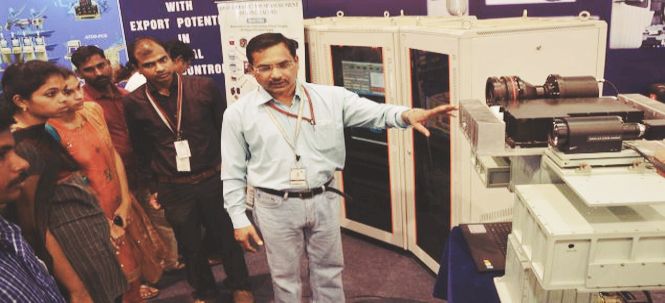Kshatriya87
New Member
- Joined
- Feb 12, 2014
- Messages
- 10,212
- Likes
- 16,124
http://www.defencenews.in/article/DRDO-unveils-LACSMI-to-boost-Navy-firepower-2735
The Laser Cross Section Measurement & Imaging System (LACSMI), developed by Laser Science and Technology Centre (LASTEC) of the Defence Research and Development Organisation was unveiled at the maritime exhibition at Visakhapatnam held as part of the International Fleet Review 2016.
Most of the Indian Navy's latest warships possess stealth capabilities but till now there was no way of measuring exactly how much is good enough to fool the laser seekers. It will be LACSMI's job to carry out imaging of ships as well as tanks and other military vehicles to find the 'hotspots' that give away their location to the enemy.
"This technology is in a nascent stage worldwide and no such system is reported in open literature or available inventory of any developed nation's armed forces. This was developed indigenously and is an excellent example of 'Make in India' efforts. Electro-optically guided precision strike munitions, commonly known as laser guided and infrared guided munitions have proved how lethal they are in recent conflicts around the globe. In laser-guided munitions, the target is illuminated by a laser designator and laser seeker head installed within the bomb or missile. They make use of laser-scattered radiation from the targets to command the weapon to strike with remarkable precision. Such weapons are widely used nowadays and pose an increasingly serious threat to strategic targets. In order to modify existing platforms to make them stealthier or design new generation stealth platforms, a system which can measure and record laser signature was required;" says Dr Ravindra Singh, project director at LASTEC.
Singh added: "It can provide online and offline laser signature measurement, generate laser 3D images, identify hotspots and automatically video track sea and airborne targets. It also has the capability to give motion compensated laser signature and 3D images, which is contemporary technology developed for the first time ever."
Madhuri Yadav, who has been working closely with Singh, says that the system was developed in 2014 but took a while to test and adjust. Now, it will be set-up on Dolphin Hill at the naval dockyard in Visakhapatnam.
It will constantly be sending out a radar beam to a distance of up to five km to pick up targets. The laser is totally eye safe.
The Laser Cross Section Measurement & Imaging System (LACSMI), developed by Laser Science and Technology Centre (LASTEC) of the Defence Research and Development Organisation was unveiled at the maritime exhibition at Visakhapatnam held as part of the International Fleet Review 2016.
Most of the Indian Navy's latest warships possess stealth capabilities but till now there was no way of measuring exactly how much is good enough to fool the laser seekers. It will be LACSMI's job to carry out imaging of ships as well as tanks and other military vehicles to find the 'hotspots' that give away their location to the enemy.
"This technology is in a nascent stage worldwide and no such system is reported in open literature or available inventory of any developed nation's armed forces. This was developed indigenously and is an excellent example of 'Make in India' efforts. Electro-optically guided precision strike munitions, commonly known as laser guided and infrared guided munitions have proved how lethal they are in recent conflicts around the globe. In laser-guided munitions, the target is illuminated by a laser designator and laser seeker head installed within the bomb or missile. They make use of laser-scattered radiation from the targets to command the weapon to strike with remarkable precision. Such weapons are widely used nowadays and pose an increasingly serious threat to strategic targets. In order to modify existing platforms to make them stealthier or design new generation stealth platforms, a system which can measure and record laser signature was required;" says Dr Ravindra Singh, project director at LASTEC.
Singh added: "It can provide online and offline laser signature measurement, generate laser 3D images, identify hotspots and automatically video track sea and airborne targets. It also has the capability to give motion compensated laser signature and 3D images, which is contemporary technology developed for the first time ever."
Madhuri Yadav, who has been working closely with Singh, says that the system was developed in 2014 but took a while to test and adjust. Now, it will be set-up on Dolphin Hill at the naval dockyard in Visakhapatnam.
It will constantly be sending out a radar beam to a distance of up to five km to pick up targets. The laser is totally eye safe.


